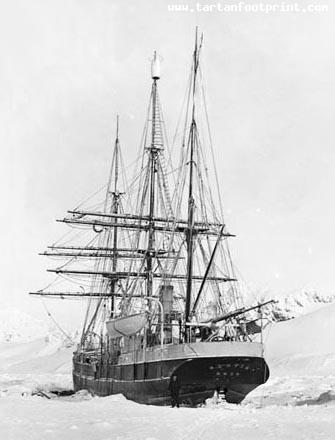You seem to be using an older version of Internet Explorer. This site requires Internet Explorer 8 or higher. Update your browser here today to fully enjoy all the marvels of this site.
February 15, 2019 by Alexander Meldrum
Did you Know that Scot of the Antartic was not the only one to Explore there?
Scottish National Antarctic Expedition
The Scottish National Antarctic Expedition (SNAE), 1902–04, was organized and...Did you Know that Scot of the Antartic was not the only one to Explore there?
Scottish National Antarctic Expedition
The Scottish National Antarctic Expedition (SNAE), 1902–04, was organized and led by William Speirs Bruce, a natural scientist and former medical student from the University of Edinburgh.
Although overshadowed in prestige terms by Robert Falcon Scott's concurrent Discovery Expedition, the SNAE completed a full programme of exploration and scientific work.
Its achievements included the establishment of a manned meteorological station, the first in the Antarctic territory, and the discovery of new land to the east of the Weddell Sea.
Its large collection of biological and geological specimens, together with those from Bruce's earlier travels, led to the establishment of the Scottish Oceanographical Laboratory in 1906. Bruce had spent most of the 1890s engaged on expeditions to the Antarctic and Arctic regions, and by 1899 was Britain's most experienced polar scientist.
In March of that year, he applied to join the Discovery Expedition; however, his proposal to extend that expedition's field of work into the Weddell Sea quadrant, using a second ship, was dismissed as "mischievous rivalry" by Royal Geographical Society (RGS) president Sir Clements Markham.
Bruce reacted by obtaining independent finance; his venture was supported and promoted by the Royal Scottish Geographical Society. The expedition has been described as "by far the most cost-effective and carefully planned scientific expedition of the Heroic Age."Despite this, Bruce received no formal honour or recognition from the British Government, and the expedition's members were denied the prestigious Polar Medal despite vigorous lobbying. After the SNAE, Bruce led no more Antarctic expeditions, although he made regular Arctic trips. His focus on serious scientific exploration was out of fashion with his times, and his achievements, unlike those of the polar adventurers Scott, Shackleton, and Amundsen, soon faded from public awareness.
The SNAE's permanent memorial is the Orcadas weather station, which was set up in 1903 as "Omond House" on Laurie Island, South Orkneys, and has been in continuous operation ever since.
The Ship Scotia
In the autumn of 1901, Bruce purchased a Norwegian whaler, Hekla, at a cost of £2,620 (approximately £280,000 as of 2019).
During the following months, the ship was completely rebuilt as an Antarctic research vessel, with two laboratories, a darkroom, and extensive specialist equipment.
Two huge revolving cylinders, each carrying 6,000 fathoms (36,000 ft; 11,000 m) of cable, were fitted to the deck to enable deep-sea trawling for marine specimens.
Other equipment was installed for making depth soundings, for the collection of seawater and sea-bottom samples, and for meteorological and magnetic observations.
The hull was massively reinforced to withstand the pressures of Antarctic ice, and the ship was re-rigged as a barque with auxiliary engines. This work increased the cost of the ship to £16,700 (approximately £1,780,000 as of 2019, which was met by the Coats family who altogether donated £30,000 towards the total expedition costs of £36,000.
Renamed Scotia, the ship was ready for her sea trials in August 1902.
Personnel
The expedition's scientific staff consisted of six persons, including Bruce. The zoologist was David Wilton who, like Bruce, had been a member of the Jackson-Harmsworth Expedition.
He had acquired skiing and sledging skills during several years living in northern Russia.
Robert Rudmose-Brown, of University College, Dundee, and formerly an assistant in the Botany Department at the British Museum, was the party's botanist. Dr. James Harvie Pirie, who had worked in the Challenger office under John Murray, was geologist, bacteriologist, and the expedition's medical officer. Robert Mossman directed meteorological and magnetic work, and Alastair Ross, a medical student, was a taxidermist.
Bruce appointed Thomas Robertson as Scotia's captain. Robertson was an experienced Antarctic and Arctic sailor who had commanded the whaling ship Active on the Dundee Whaling Expedition.
The rest of the 25 officers and men, who signed for three-year engagements, were all Scotsmen, many used to sailing in icy waters on whaling voyages.
Objectives
The objectives of the expedition were published in the Scottish Geographical Magazine and in the RGS Geographical Journal, in October 1902. They included the establishment of a winter station "as near to the South Pole as is practicable", deep sea and other research of the Antarctic Ocean, and systematic observations and research of meteorology, geology, biology, topography and terrestrial physics.
The essentially Scottish character of the expedition was expressed in The Scotsman shortly before departure: "
The leader and all the scientific and nautical members of the expedition are Scots; the funds have been collected for the most part on this side of the Border;
it is a product of voluntary effort, and unlike the expedition which will be simultaneously employed in the exploration of the Antarctic, it owes nothing to Government help".
As the work of the expedition would be mainly at sea, or within the confines of the winter station, only a few dogs were taken, to facilitate the occasional sledge journey.
Rudmose Brown records that of the original eight dogs, four survived the expedition; they "pulled well in harness, their only weak point being their paws which... were apt to be cut when on rough ice"
Go to Wikipedia for full History
In this photo:


